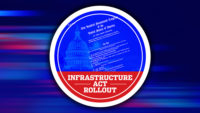The recently enacted Inflation Reduction Act contains highway-related provisions that aim to give a boost to infrastructure projects in disadvantaged communities and for the use of low-carbon construction materials on federal highway projects.
The larger of the two provisions provides $1.89 billion in fiscal 2022 funds for a new U.S. Dept. of Transportation Neighborhood Access and Equity Grants program, plus $1.26 billion for projects in economically disadvantaged areas.
U.S. DOT's Federal Highway Administration will award the access and equity grants through a competition among states, localities, transportation authorities and other entities.
Grants would go for projects such as efforts to reconnect neighborhoods that have been cut off from economic, educational or other opportunities by highways, rail lines and other transportation facilities, some of them decades old.
The new program is similar to the Infrastructure Investment and Jobs Act's Reconnecting Communities pilot program, whose main focus is removing or reconfiguring highways and other transportation projects—some of them in place for decades—that have cut neighborhoods off from economic, educational and other opportunities. It is funded at $1 billion over five years.
U.S. DOT on June 30 issued a formal funding-availability notice for $195 million in grants for Reconnecting Communities' first year.
The new neighborhood access and equity and disadvantaged neighborhoods funding is more than triple the IIJA program's total five-year level.
The new provision also widens the scope of eligible projects in disadvantaged neighborhoods to include new or upgraded multi-purpose trails, “greenways,” and installing noise barriers or pervious or porous pavements to counter stormwater runoff.
The $1 billion in the IIJA for Reconnecting Communities was much smaller than President Joe Biden's March 2021 $20-billion proposal for the program.
The new program narrows the gap a bit. Susan Howard, American Association of State Highway and Transportation Officials director of policy and government relations, says, “There was certainly a desire in the administration to have a much more robust program [for Reconnecting Communities]."
Howard adds that the new funding "could be a little bit of backfilling" to increase the level closer to what administration officials wanted to see.
One incentive for applicants seeking disadvantaged-communities grants is that the projects can be 100% federally funded. “There are very few programs that are 100% federal share,” Howard notes.
FHWA may address how the IIJA and Inflation Reduction Act programs will work with each other in future implementation guidance.
Sean O’Neill, Portland Cement Association senior vice president of government affairs, said in an interview that the neighborhood access and equity program “could be kind of a net positive" for companies in the cement and concrete industry. He acknowledges that if it leads to tear-downs of major highway sections or other large new road plans, that could increase the impact on those industries.
Jay Hansen, National Asphalt Pavement Association executive vice president for advocacy, said in an interview that whether the neighborhood access and equity grants result in significant additional construction work “depends on FHWA guidance and the type of projects that are eligible for funds.”
Based on the text of the legislation, he doesn’t think it will lead to a major increase in construction.
PCA and NAPA are looking forward to the implementation of the new law's low-carbon materials program, O’Neill says that PCA members “have made a pledge to be carbon-neutral by 2050 throughout the cement and concrete value chain. A big part of that is creating a market for low-carbon building materials.”
O'Neill says that one key focus is Portland limestone cement (PLC), which he says has a carbon intensity about 10% lower than for traditional Portland cement.
He says that 46 state transportation departments now allow for the use of Portland limestone cement in their specifications.
O’Neil says, “How the new low-carbon provision plays out "remains to be seen.” But he adds, “We like the direction that this could go in ... we feel that this hopefully will continue to expand the market for PLC.”
The statute provides $2 billion for FHWA to reimburse or provide incentives to states or other entities that use “low-embodied carbon" transportation materials and products on federal-aid highways or roads on tribal or federal lands.
Reimbursements will “equal the incrementally higher cost" of low-carbon materials, compared with traditional materials. Incentives would equal 2% of the cost of the low-carbon products.
One restriction is that, under the new law, the low-carbon incentives and reimbursement do not apply to projects that add “travel lanes for single-occupant passenger vehicles.”
It will be up to the Environmental. Protection Agency to identify what qualifies as a low-embodied carbon construction material or product.
NAPA's Hansen, said in emailed comments that with the combination of the Inflation Reduction Act provisions and IIJA provisions—such as that law's Carbon Reduction Program— there is every reason to expect” that state DOTs and contractors will increase use of low embodied carbon paving materials. He says, “It will start slow and intensify over time.”
Some steps that asphalt companies can take, he says, include running more reclaimed asphalt pavement, using more warm-mix asphalt and change burner fuels at their plants.
Hansen also says, “State highway specifications will need to be addressed if we want to innovate more.”
The statute also includes $100 million for the EPA to develop a program to identify and label low-embodied carbon construction materials. That program is to be developed in consultation with FHWA and the General Services Administration.
The law also has $2.15 billion for GSA to "acquire and install" low-carbon products and materials for federal buildings
Hansen says that the guidance documents from the federal agencies for the low-carbon program will be important. “For the first time,” he notes, “EPA will be identifying and labeling construction materials with substantially lower levels of embodied greenhouse gas emissions.”
FHWA then will chose from the EPA list which materials will qualify for the incentives or reimbursements, Hansen says.





Post a comment to this article
Report Abusive Comment